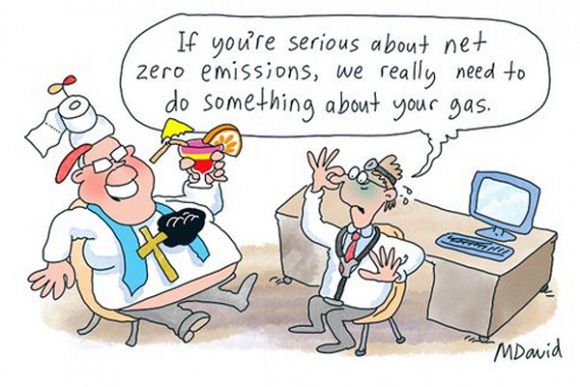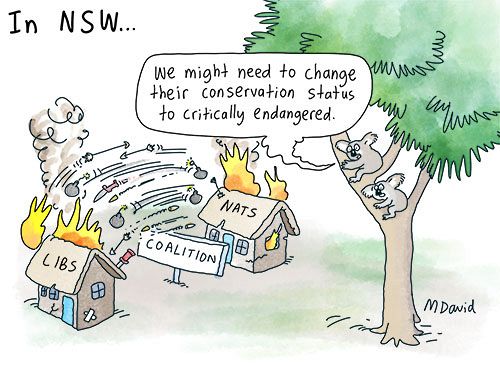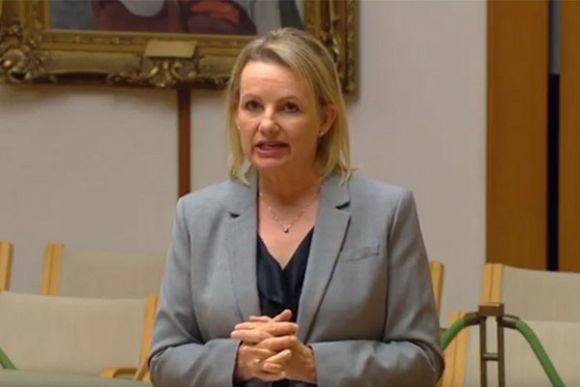The Federal Budget has generated a lot of comments. It is certainly based on an unprecedented fiscal expansion; but there are fiscal expansions and then there are fiscal expansions. Annabel Crabb put it this way: "It recognises the people it wants to help, and screw the rest." She's right.
After that, the few who won biggly and the many who were left out in the cold made their voices heard. In the cacophony resulting, even Morrison's gas-fueled technology roadmap, designed to make Australia forever dependent on fossil fuels, was forgotten. You see, whether by accident or by design, it was announced before the budget, almost as if to make it sure people would be too worried about their own livelihoods to care about climate change.
And yet, as terrible as all that is, there is yet another piece of bad news people have overlooked:
Federal Budget condemns our wildlife to extinction

The 2020 Federal Budget has focused on economic interests and forsaken rebuilding our devastated environment, writes Sue Arnold.
THE COMPLETE FAILURE of the Morrison/Frydenberg Budget to address the catastrophic state of Australia’s environment is well demonstrated by the user guide in the budget paper for agriculture, water and environment portfolio (page 9).
Not one mention of biodiversity.
Three ministers share the agriculture, water and environment portfolio. David Littleproud, deputy leader of the National Party, is responsible for agriculture, drought and emergency management. Sussan Ley is Minister for the Environment and Keith Pitt, Queensland National Party MP, is responsible for resources, water and Northern Australia.
The Commonwealth portfolio responsibilities include the Cotton Research and Development Corporation (CRDC) and numerous entities which are in conflict with any environmental focus.
The National Party has control of primary environmental resources at the national level and in the NSW Government.
This Budget paper should fill every concerned Australian with alarm. Not only is the overview paper an exercise in spin, as evidenced in the list of outcomes, but funding for urgent environmental priorities is ignored.
In fact, the outcomes are focused on economic interests. At a time when scientists have estimated 3 billion animals were lost in the bushfires, logging is out of control in NSW and Victoria, the EPBC Act is about to be further weakened unless the amendments are blocked in the Senate, the Budget paper should be a clarion call for action.
Our besieged wildlife is in desperate need of habitat protection, stronger laws to protect their future survival and a national focus on recovery.
Last month, the Morrison Government rammed the EPBC Act amendment through the House of Representatives, further weakening the legislation described in the Budget paper as:
In 2020–21 we are at a pivotal point in our national environmental protection efforts. Planning is underway to deliver a reform program that revitalises the legislative and policy framework for environment protection. This will ensure ongoing ecologically sustainable development that is both streamlined for businesses and effectively protects the environment.
One has to ask, how do these guys sleep at night?
According to the paper:
Our environment has begun the long journey towards recovery from the Black Summer bushfires. The early positive signs are encouraging, but the recovery of native wildlife and their habitats will require significant effort and long-term planning. We have supported the commitment of funds for the recovery of our biodiversity and ecosystems. We are also working across government to provide support to affected farmers, fishers and foresters, along with rural, regional and urban communities. We are committed to the sustained effort that will be needed to support bushfire- affected areas.
Exactly where has the environment begun ‘the long journey towards recovery’? And what ‘early positive signs are encouraging’?
Funds for the recovery of biodiversity and ecosystems consist of promises and meagre allocations of dollars.
Let’s not forget that Morrison is the same man who was quoted by The Guardian a year ago after his address to the U.N. responding to a speech by Swedish teenage climate activist Greta Thunberg:
“I want children growing up in Australia to feel positive about their future and I think it is important we give them that confidence that they will not only have a wonderful country and pristine environment to live in, that they will also have an economy to live in as well.”
According to reports of Morrison’s speech, his focus was confined to ocean management, plastics, waste management and illegal fishing.
In October 2019, 240 conservation scientists signed an open letter warning Morrison that:
‘Australia is amid an extinction crisis. We are documenting the rapid decline in the overall numbers of species and the overall diversity of wildlife across the land, rivers and seas of our country.
Australia’s native species are disappearing at an alarming rate.’
Without doubt, the plight of koalas is a major concern for the public. Given the millions of dollars donated by Australians and overseas celebs, organisations and concerned citizens, the Budget fails to recognise the koalas’ plight.
Yet in November 2019, Minister Ley’s office advised the following commitments were made at the Brisbane koala round table:
We have committed $3 million for the protection of koala habitat in South East Queensland and Northern NSW from the Environment Restoration Fund.
Thursday’s meeting was an important chance to identify and prioritise actions resulting from the bushfires.
The workshop considered the ongoing impact of fires and identified priority actions:
- assessing the needs of wildlife carers and animal hospitals on the immediate front line with state and federal governments reaching out to provide and coordinate further assistance, identifying suitable release sites for rehabilitated koalas. Governments are already providing funding support;
- a rapid mapping of the impact on known koala habitat and, importantly, to identify areas where healthy Koala populations remain;
- identifying the importance of remaining koala habitat and populations as significant environmental assets and developing management strategies for their protection;
- identifying corridor strategies to link habitat areas along Northern NSW and Southern Queensland;
- management of koala habitat should address a range of threats including fragmentation, degradation of habitat and the impacts of fire;
- management could include establishing fire breaks and undertaking controlled burns when safe to do so to reduce the risk of destructive fires. In addition working with rural fire services so they are aware of important koala habitat and can help protect it when they have capacity, recognising that protection of people and property is their priority; and
- longer term funding can support regeneration of degraded habitat to increase the area available for koalas and improve connectivity between these areas.
IA has not been able to identify any actions taken to prioritise or much less acted upon as a result of the Brisbane koala round table. Earlier this year, $6.9 million was approved for 19 projects by the Federal Government. None of the grants was focused on koalas.
Outcome l in the Budget paper details the forecast performance results in 2019-2020.
The outcome is defined as:
Conserve, protect and sustainably manage Australia’s biodiversity, ecosystems, environment and heritage through research, information management, supporting natural resource management, establishing and managing Commonwealth protected areas, and reducing and regulating the use of pollutants and hazardous substances, and coordination of climate change adaptation strategy and climate change science activities.
The objective:
‘...to improve the extent, condition and connectivity of Australia’s unique biodiversity and natural resources, including the Great Barrier Reef, through protection of habitats and mitigation of threats to threatened species and ecological communities.’
Under Performance information/criteria the following is stated:
Australia’s biodiversity including priority threatened species, ecological communities, cetaceans and migratory species, and significant heritage places are conserved and protected via targeted investments and collaborative partnerships.
Targets: Program objectives are delivered under the National Landcare Program and other key programs, including improving your local parks and environment program and the Australian heritage Grants Program.
Outcome? Achieved.
It’s extremely difficult to understand how the National Landcare Program has any influence on cetaceans.
In the same way that President Trump has downplayed COVID-19, even as he’s now infected, PM Morrison is following the U.S. President’s playbook.
Instead of 210,000 human lives lost, the Australian leader is condemning our wildlife to extinction. The Budget is a national disgrace.
Sue Arnold is an IA columnist and freelance investigative journalist. You can follow Sue on Twitter @koalacrisis.
Related Articles
- Environment is the enemy of Right-wing governments
- Government eager to reintroduce harmful environmental legislation
- Morrison Government ignores environmental review recommendations
- COVID-19 pandemic has affected food security and sustainability
- Snowy 2.0 doesn't measure up economically or environmentally
 This work is licensed under a Creative Commons Attribution-NonCommercial-NoDerivs 3.0 Australia License
This work is licensed under a Creative Commons Attribution-NonCommercial-NoDerivs 3.0 Australia License



No comments:
Post a Comment